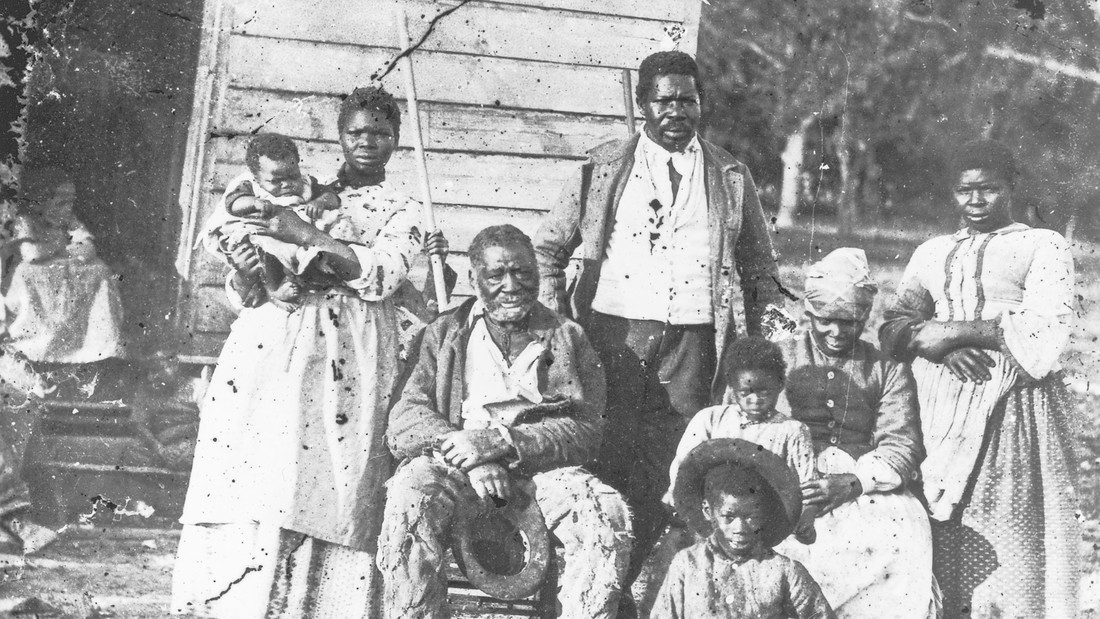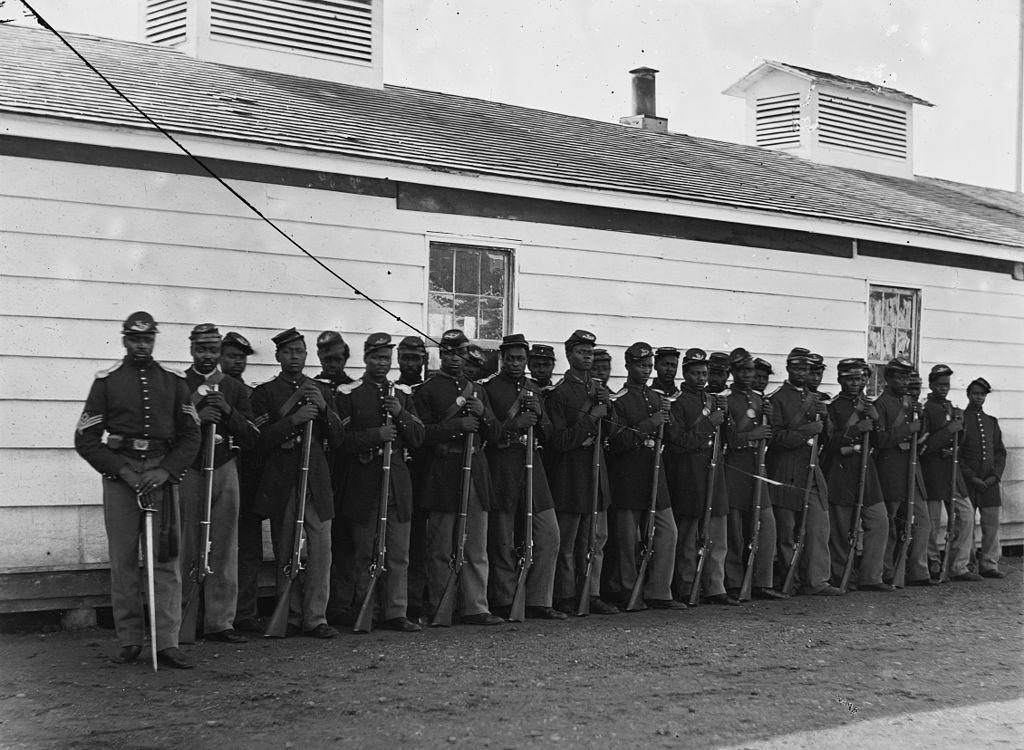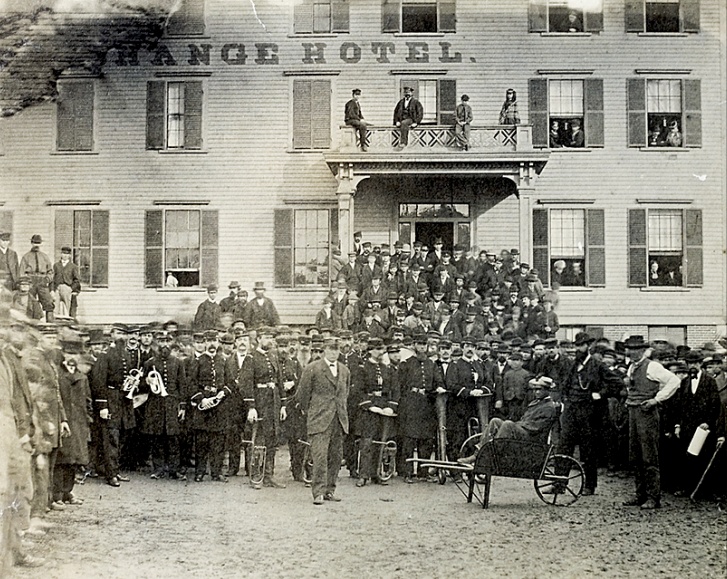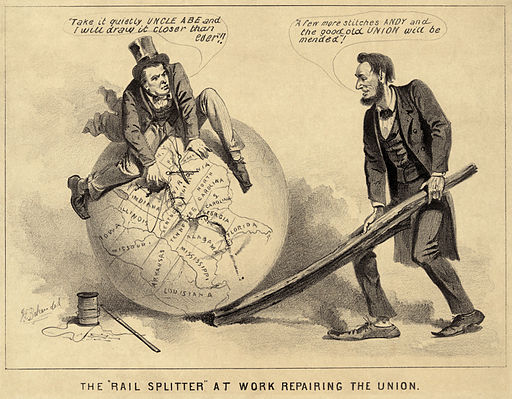
Aftermath of Slavery
Liberation

Slaves played a pivotal role in their own liberation. During the first two years of the Civil War, federal officials refused to enlist black soldiers in the Union Army. But by early 1863, voluntary enlistments had fallen so sharply that the federal government instituted an unpopular military draft and decided to enroll black troops. Indeed, it was the availability of black troops that allowed President Lincoln to resist demands for a negotiated peace that might have retained slavery in the United States.
Altogether, 186,000 black soldiers served in the Union Army and another 29,000 served in the Navy, accounting for nearly ten percent of all Union forces and 68,178 of the Union dead or missing. Three fifths of all black troops were former slaves. The active participation of black troops made it inconceivable that African Americans would remain in slavery after the Civil War.
During the war, hundreds of thousands of Southern slaves contributed to their own emancipation by deserting plantations and fleeing to Union lines. While slave staged few insurrections during the war, the slave system began to unravel. Planters were stunned to see trusted house slaves and drivers lead field hands in deserting to the Union army.
“The Fifteenth Amendment, Celebrated May 19, 1870”
This lithograph’s central image shows a parade in Baltimore, Maryland, celebrating the ratification of the fifteenth amendment, which extended the vote to African American men. Surrounding the parade scene are portraits of President Ulysses S. Grant, Vice President Schulyer S. Colfax, Martin R. Delany, a physician, author, abolitionist, and early black nationalist, the abolitionist Frederick Douglass, and Mississippi Senator Hiram R. Revels, as well as of Abraham Lincoln and John Brown.
Many of the images carry an inscription. The Bible is described as “Our Charter of Rights” and a scene of a minister preaching to his congregation is labeled “The Holy Ordinances of Religion Are Free.” An image of a classroom is inscribed “Education Will Prove the Equality of the Races.” A wedding ceremony states that “Liberty Protects the Marriage Altar.”A family scene says, “Freedom Unites the Family Circle”. An image of a black officer commanding his troops states,“We Will Protect Our Country as It Defends Our Rights” while three men carry a banner proclaiming “We Unite in the Bonds of Fellowship with the Whole Human Race.”


Thinking Comparatively
The Aftermath of Slavery
Except for Haiti, the American South was the only region in the Western Hemisphere in which slavery was overthrown by force of arms. It was the only region, except for Brazil, in which slave owners received no compensation for the loss of their slave property. And, it was the only post-emancipation society in which former slaves formed successful political alliances with whites (until those alliances came to an end after Reconstruction’s conclusion).

Nevertheless, the abolition of slavery did not mean that former slaves had achieved full freedom. Immediately following the war, all white state legislatures passed “black codes” designed to force freed blacks to work on plantations. These codes denied blacks the right to purchase or even rent land. Vagrancy laws allowed authorities to arrest blacks “in idleness” and assign them to a chain gang or auction them off to a planter for as long as a year. One black army veteran asked rhetorically: “If you call this Freedom, what did you call Slavery?”
Such efforts to virtually re-enslave the freedmen led Congressional Republicans to seize control of Reconstruction from President Andrew Johnson, to deny representatives from the former Confederate states their Congressional seats, to pass the Civil Rights Act of 1866, and to write the Fourteenth Amendment to extend citizenship rights to African Americans and to guarantee them equal protection of the laws. In 1870, the country went even further by ratifying the Fifteenth Amendment, which extended voting rights to black men. But, the most radical proposal advanced during Reconstruction to confiscate plantations and to redistribute portions of the land to the freedmen was defeated.
The freedman, in alliance with carpetbaggers, Northerners who had migrated to the South following the Civil War, and Southern white Republicans known as scalawags, temporarily gained power in every former Confederate state except Virginia. Altogether, over 600 blacks served as legislators in Reconstruction governments though blacks comprised a majority only in the lower house of South Carolina’s legislature. The Reconstruction governments drew up democratic state constitutions, expanded women’s rights, provided debt relief, and established the South’s first state funded schools.

During the 1870s, however, internal divisions within the Southern Republican party, white terror, and Northern apathy allowed white Democrats, known as Redeemers, to return to power in the South’s state governments. The North’s failure to enforce the Fourteenth and Fifteenth Amendments permitted racial segregation and disfranchisement in the South.
During Reconstruction, former slaves and many small white farmers became trapped in a new system of economic exploitation. Lacking capital and land of their own, former slaves were forced to work for large landowners under a system known as sharecropping. Instead of cultivating land in gangs supervised by overseers, landowners divided plantations into 20 to 50 acre plots suitable for farming by a single family. In exchange for land, a cabin, and supplies, sharecroppers agreed to raise a cash crop usually cotton and to give half the crop to their landlord. The high interest rates landlords and merchants charged for goods bought on credit transformed sharecropping into a system of economic dependency and poverty. The freedmen found that “freedom could make folks proud but it didn’t make ’em rich.”
Chattel slavery had been defeated. The gang system of labor, enforced by the whip, was dead. Real gains had been won. But, full freedom remained an unfulfilled promise.
In 1970, the countries of the Arabian peninsula became the last in the world to abolish slavery. Nevertheless, the buying and selling of human beings continues to flourish in many parts of the world. Each year, an estimated one million Asian women and children, in Bangladesh, Burma, India, Pakistan, Sri Lanka, Thailand, and elsewhere, are sold or auctioned into slavery to serve as prostitutes or child laborers. Methods of procurement have changed since the eighteenth centuries. Instead of being kidnapped, slaves are bought in impoverished villages for a few hundred dollars. The cruelties of slavery remain, with contemporary slaves chained to beds in brothels or at workbenches in sweatshops. The final chapter in the history of slavery remains unfinished.